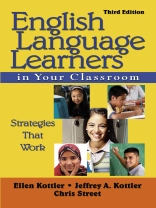’This book answers many questions about working with English Language Learners. The anecdotes, examples, and stories help make the theoretical concepts concrete. I really like the hands-on suggestions, and many of the strategies in the book can be used daily.’
—Brenna Godsey, Science Teacher
Canyon High School, Anaheim, CA
An authoritative reference for teachers facing an increasingly diverse school population.
This third edition of the best-selling Children With Limited English: Teaching Strategies for the Regular Classroom provides preservice and inservice teachers, curriculum specialists, teacher mentors, and administrators with the necessary tools to meet the educational needs of English Language Learners in an inclusive classroom.
This revised edition includes more strategies for building communication skills, increased visuals and activities for instruction, and fresh connections to current research, plus a new chapter on literacy and an expanded chapter on integrating current technology into the classroom. Additional aids include:
- A guided daily lesson plan format with adaptations for English Language Learners
- A description of language proficiency levels
- A wealth of tables, charts, and checklists to guide instruction and assessment
Spis treści
Preface
Acknowledgments
About the Authors
1. Getting to Know the Student
Sensitivity to Cultural and Linguistic Differences
Identifying Terms
Relationships Are Everything
Understand the Student′s World
Explore the Student′s Family Background
Pay Attention to Social and Cultural Customs
Suggested Activities
2. Establishing a Comfortable Environment
Welcome Students to Your Room
Select Display Materials
Establish Routines
Create a Community of Learners
Foster Classroom Involvement
Celebrate Diversity
Open Doors to Families
Suggested Activities
3. Understanding Second-Language Development
Second-Language Principles
Language Processes
Developing Proficiency
Assessing Fluency Levels
High-Stakes Testing
First- to Second-Language Learning
Suggested Activities
4. Strategies for Teaching
Motivate Students to Learn
Structure Language Delivery
Scaffold (Support) Instruction
Use Research-Based Strategies to Improve Achievement
Address Learning Styles
Incorporate Multiple Intelligences
Use Multisensory Activities to Engage Students
Suggested Activities
5. Building Literacy
Writing Skills
Reading Skills
Speaking Skills
Listening Skills
Structured Communication Activities
Responsive Instruction
Have Fun
Suggested Activities
6. Using Strategies Borrowed From Language Instruction
Learning From Foreign Language Instruction
Applying Strategies Used by English Language Teachers
Brain-Compatible Second-Language Acquisition
Summary of Strategies Adapted From Teaching Second Languages
Suggested Activities
7. Integrating Technology
Television
Telephone
Audio Recording
Video Recording
Computer Technology
Online Resources for Teachers
Promoting Critical Thinking
Benefits of Using Technology With English Learners
Suggested Activities
8. Involving Others
Peer Instruction
Team Teaching
School Personnel
Cross-Age Tutoring
Parents and Families
Intergenerational Tutoring
Community Resources
Cultural Exchange Programs
Language for All
Suggested Activities
9. Putting It All Together
Classroom Implications of Brain Research
Planning Instruction and Assessment
A Lesson Plan Format
The Power of Language
Suggested Activities
References
Index
O autorze
Chris Street, Ph.D. is an associate professor of Secondary Education at California State University, Fullerton. He received his Ph.D. from the University of Texas, Austin. He earned his M.A. from California State University, San Diego and his B.A. from the University of California, Santa Barbara. Chris has taught English language learners at both the middle-school and college levels. He currently serves on the editorial advisory board for the Journal of Content Area Reading and is a teacher consultant with the National Writing Project. His research interests include adolescent literacy and the teaching of reading and writing. His work has appeared in a variety of journals and books, including Teacher Education Quarterly, The Social Studies, Journal of Content Area Reading, Multicultural Education, Journal of College Reading and Learning, Journal of Adolescent & Adult Literacy, and Comprehending Nonfiction 6-8.












